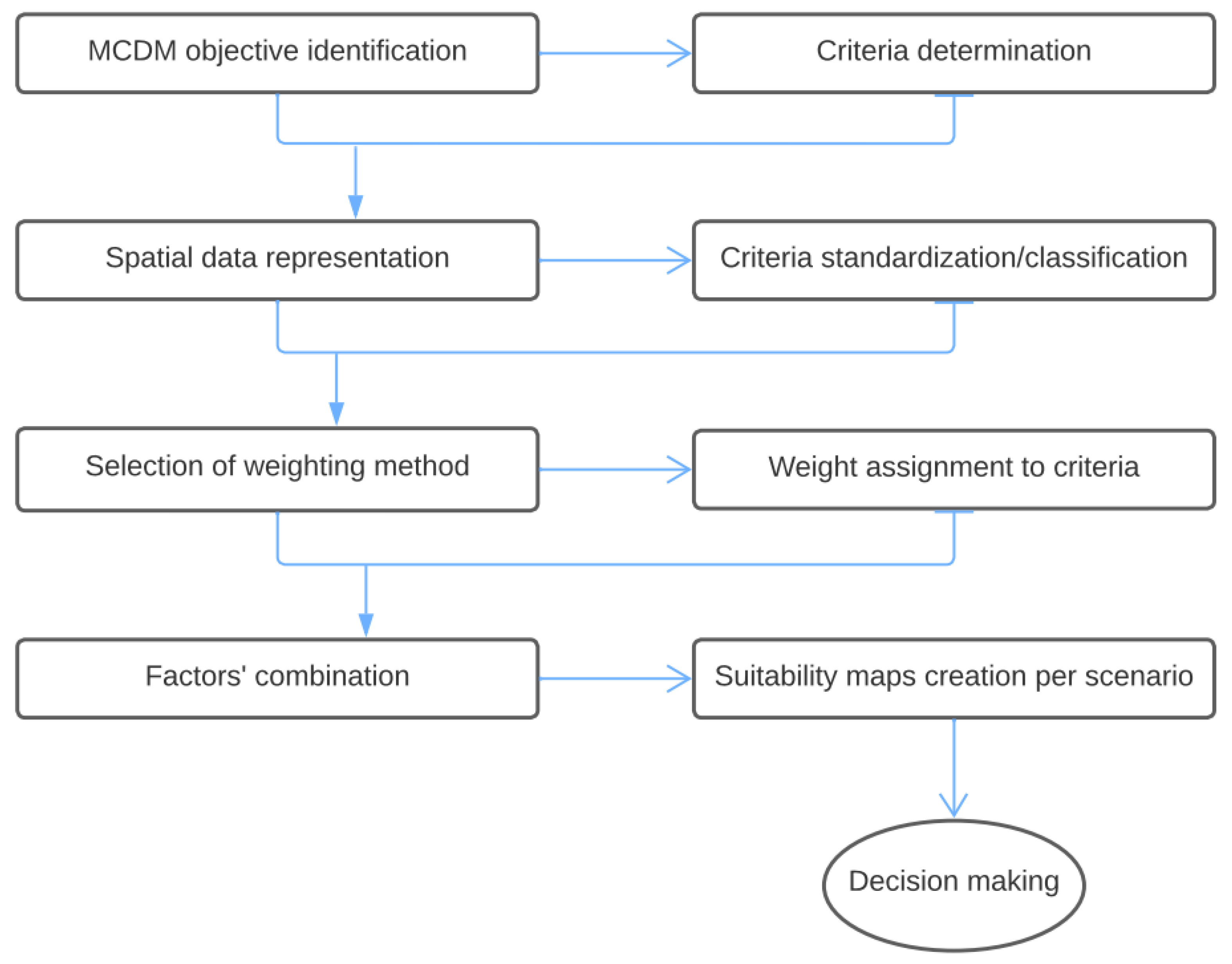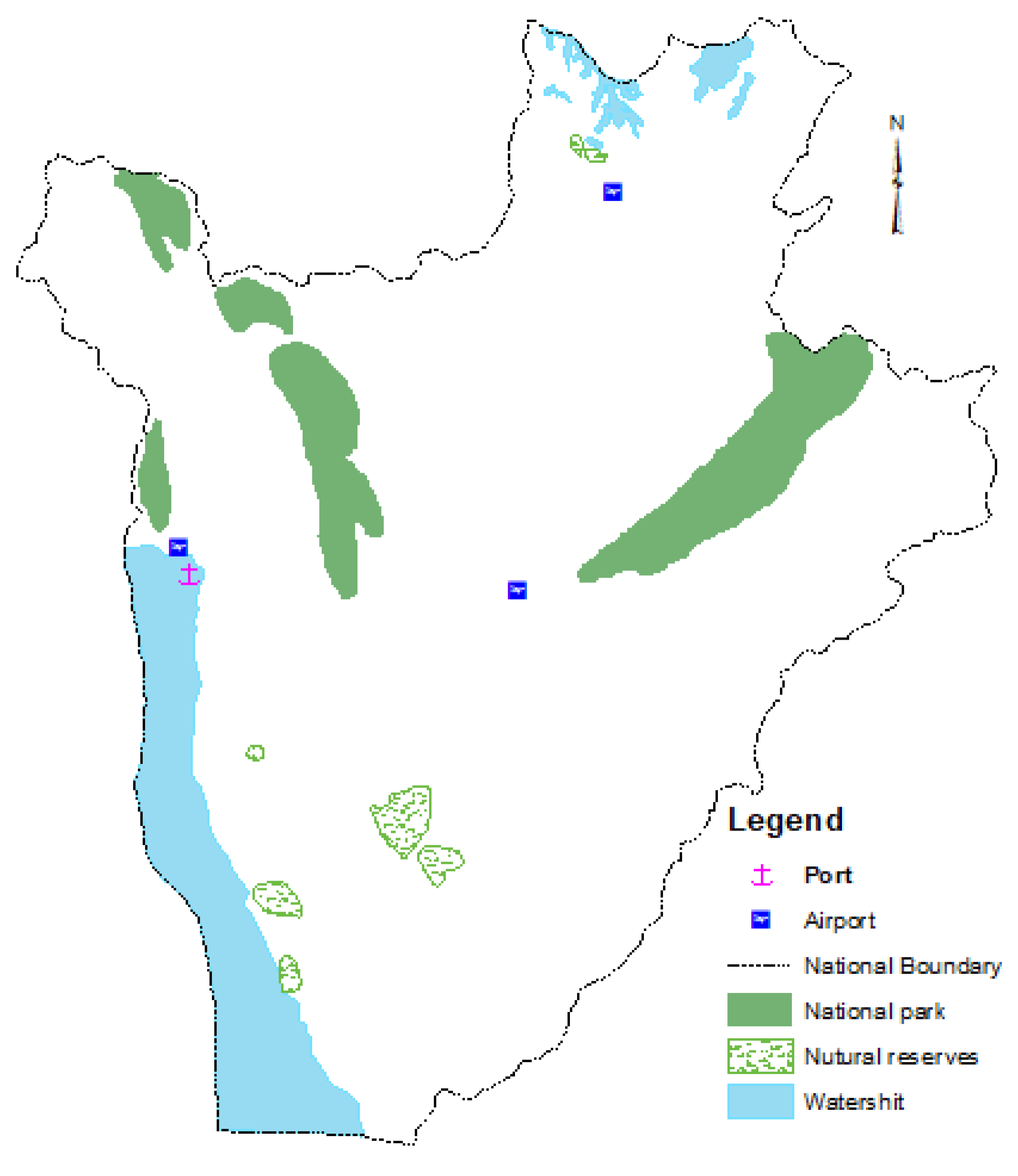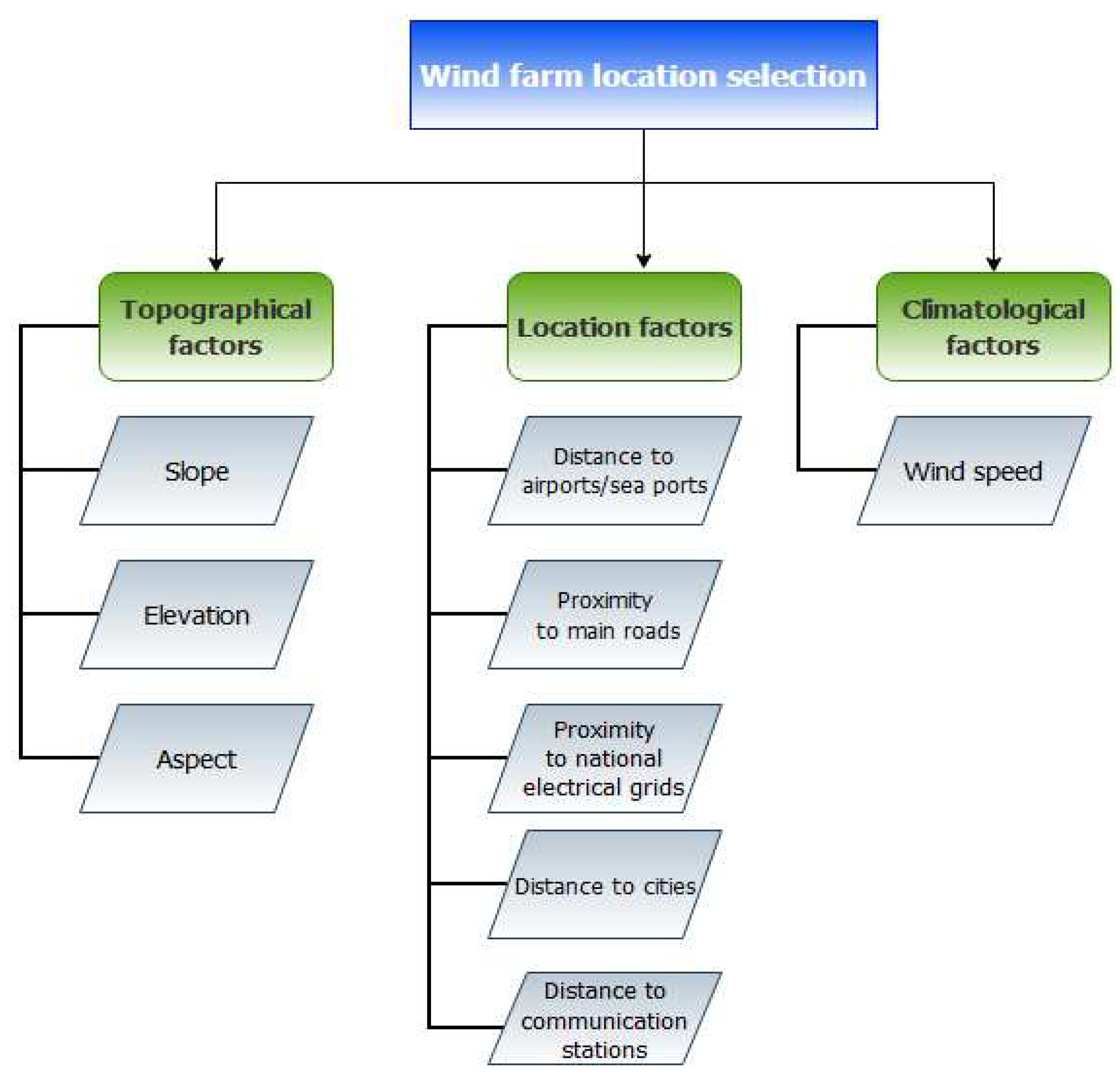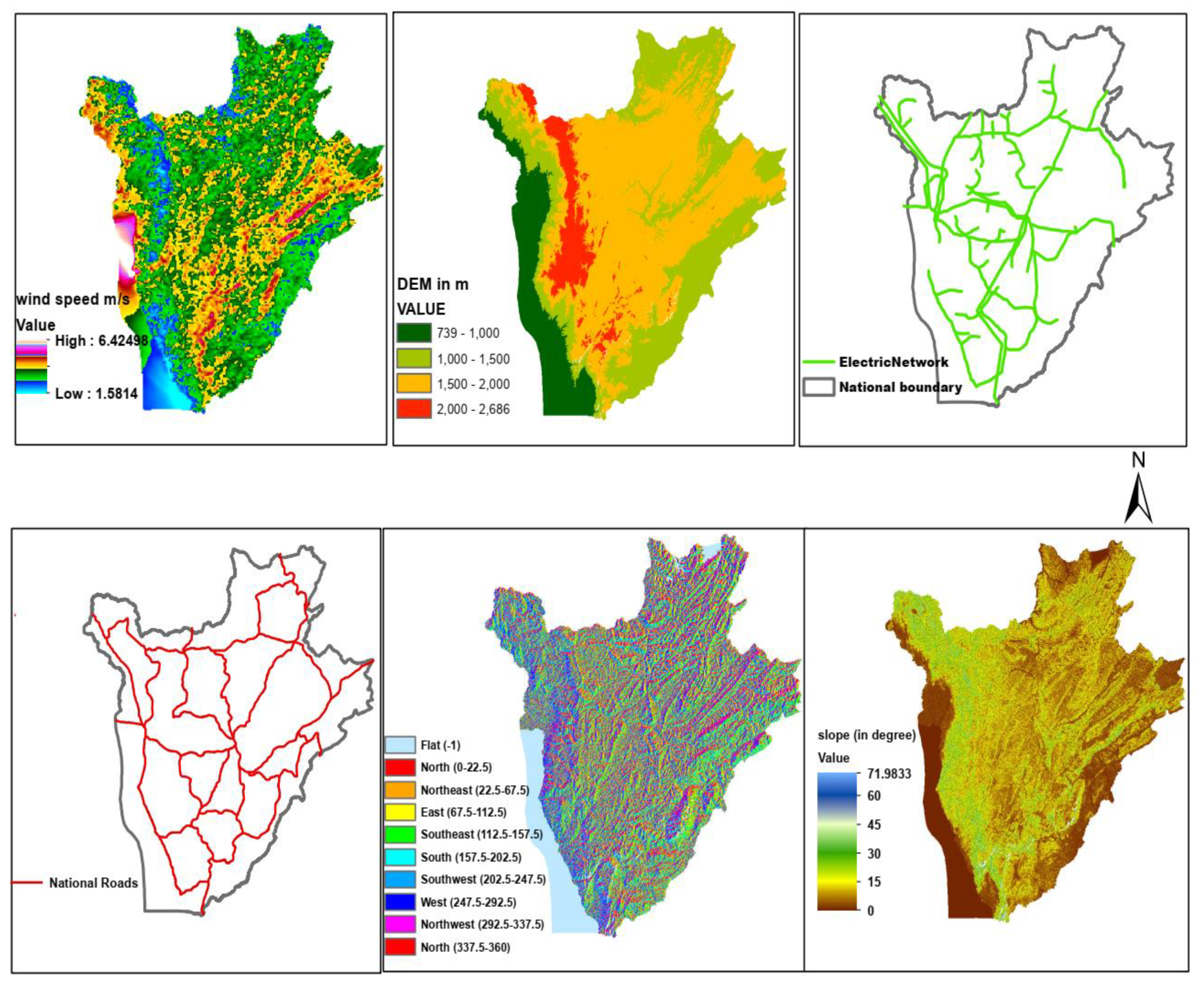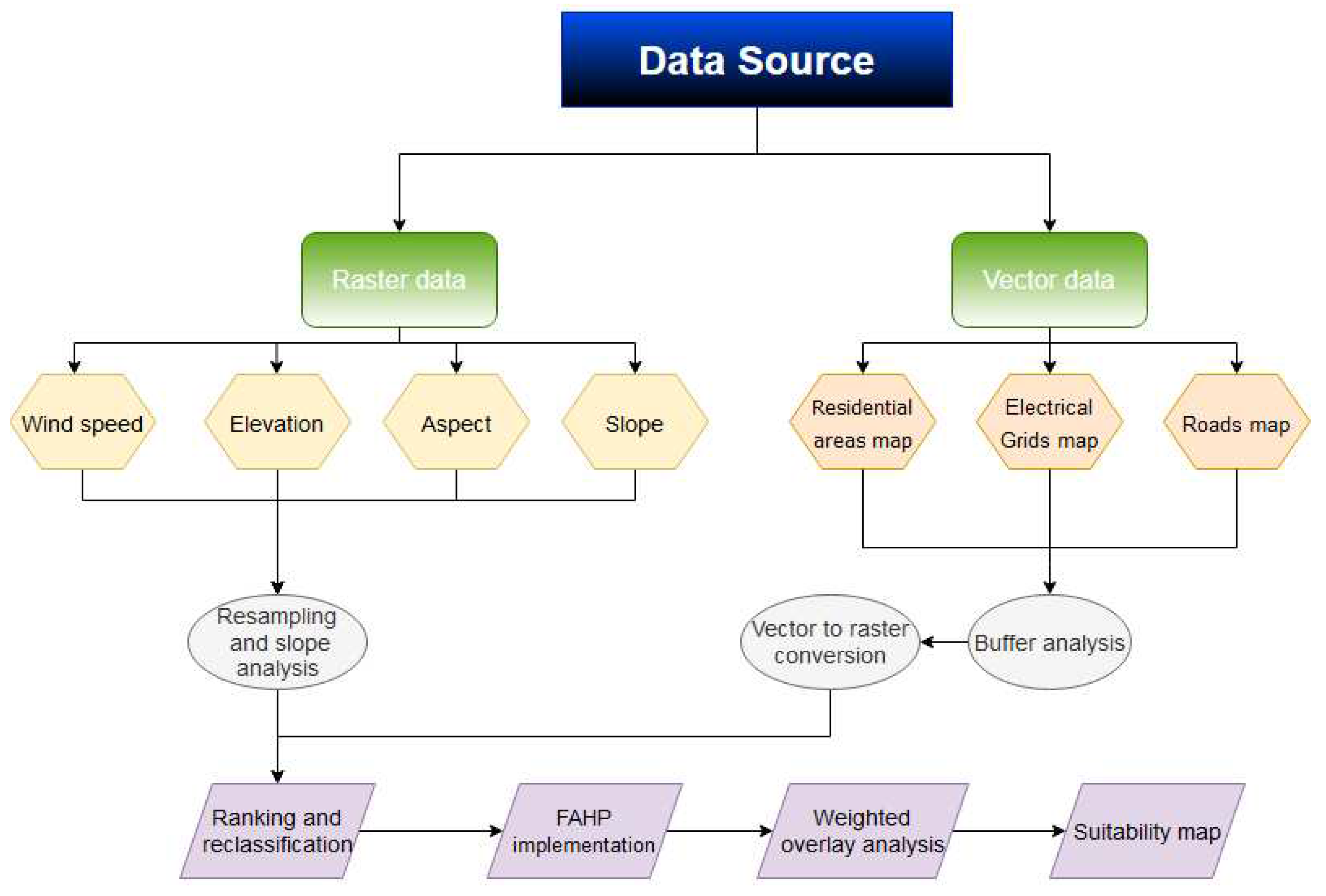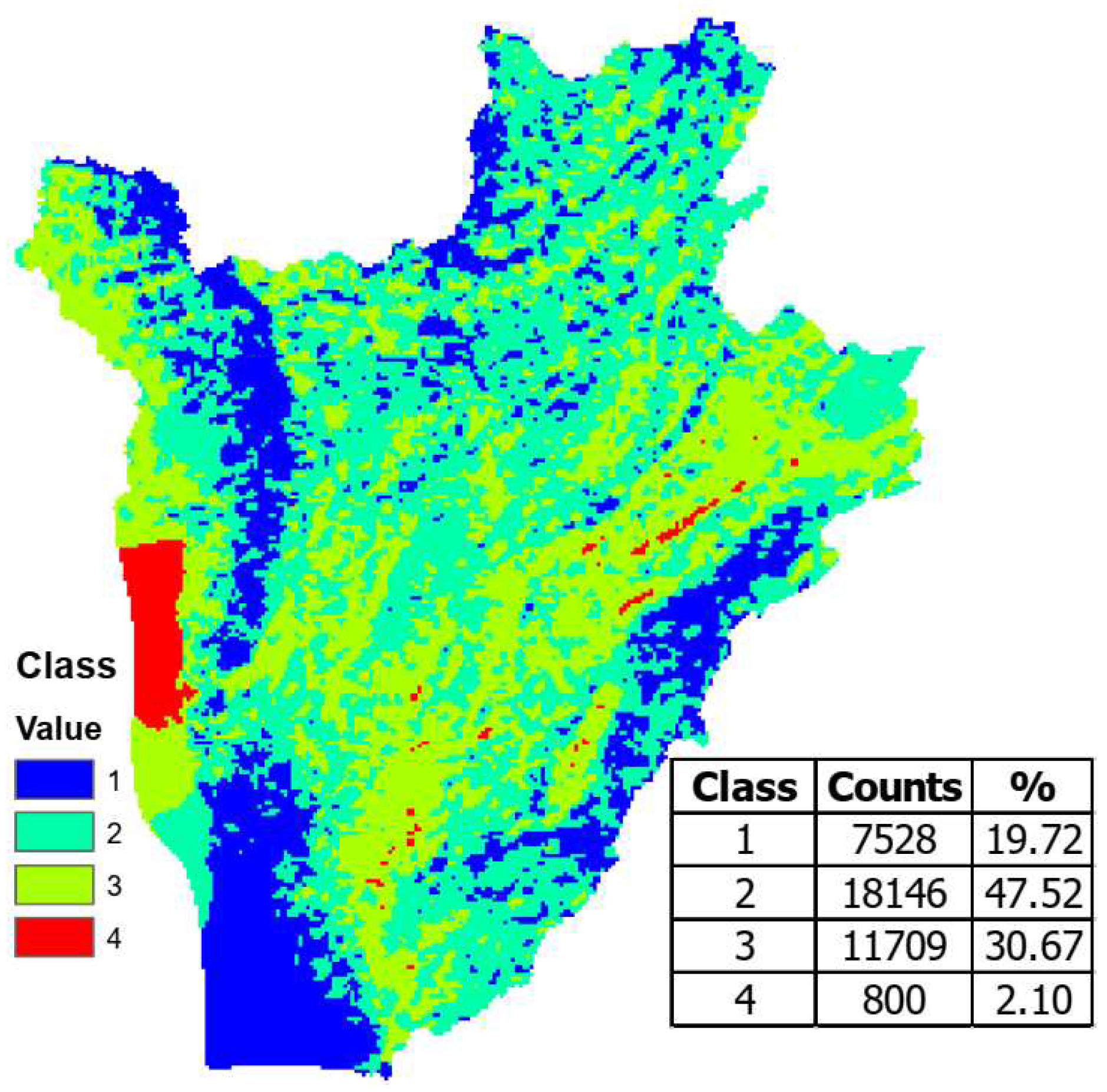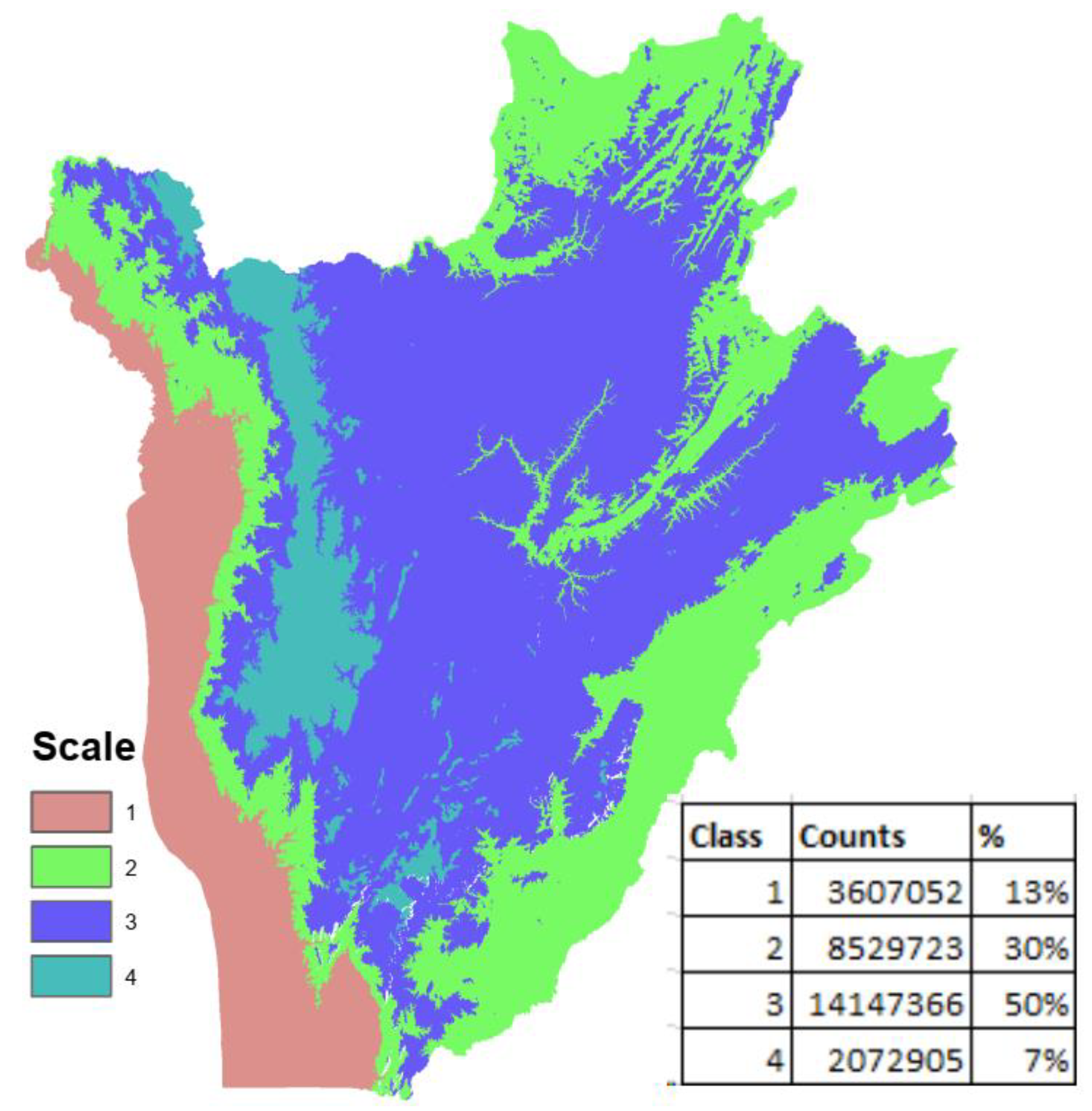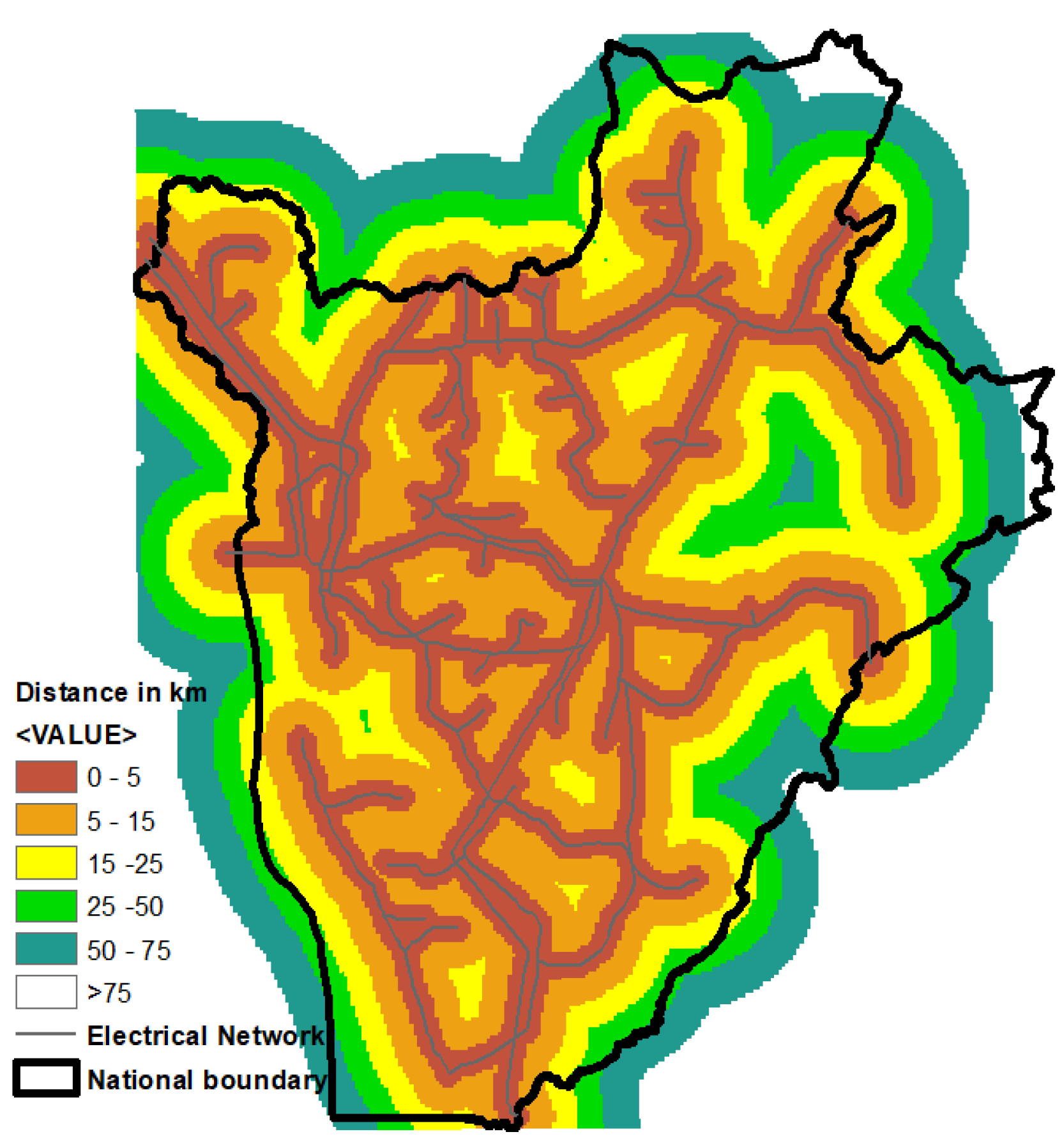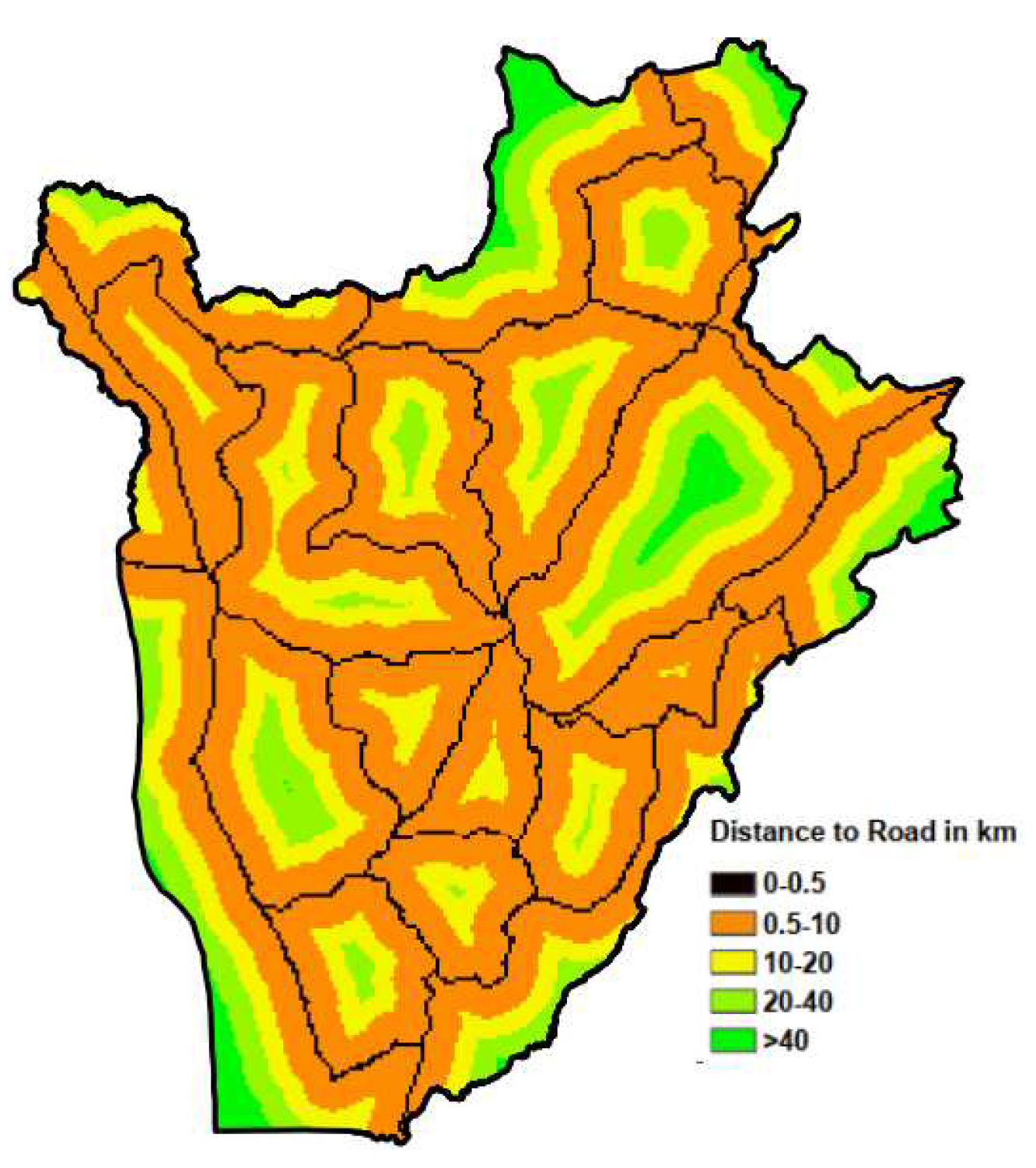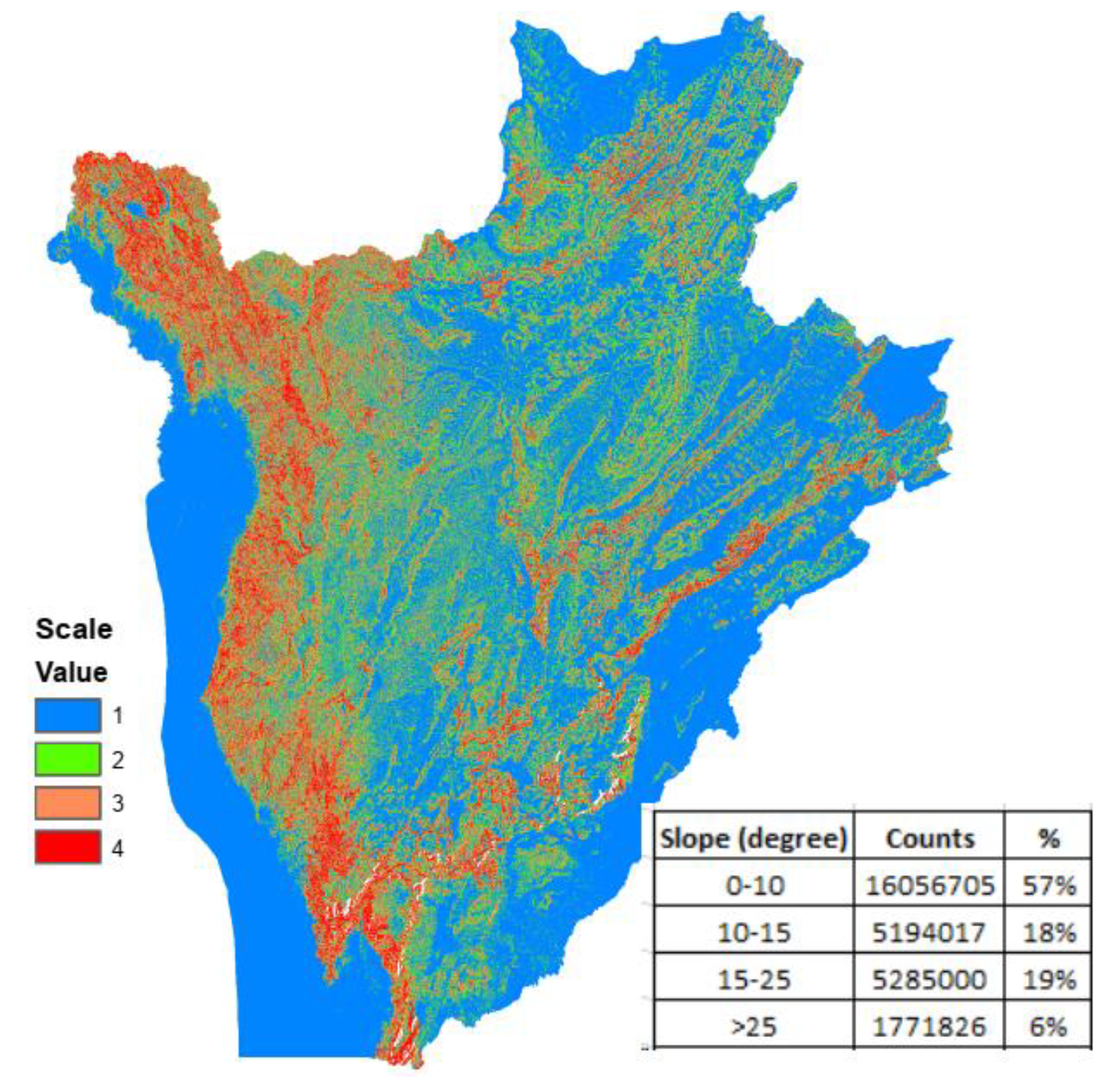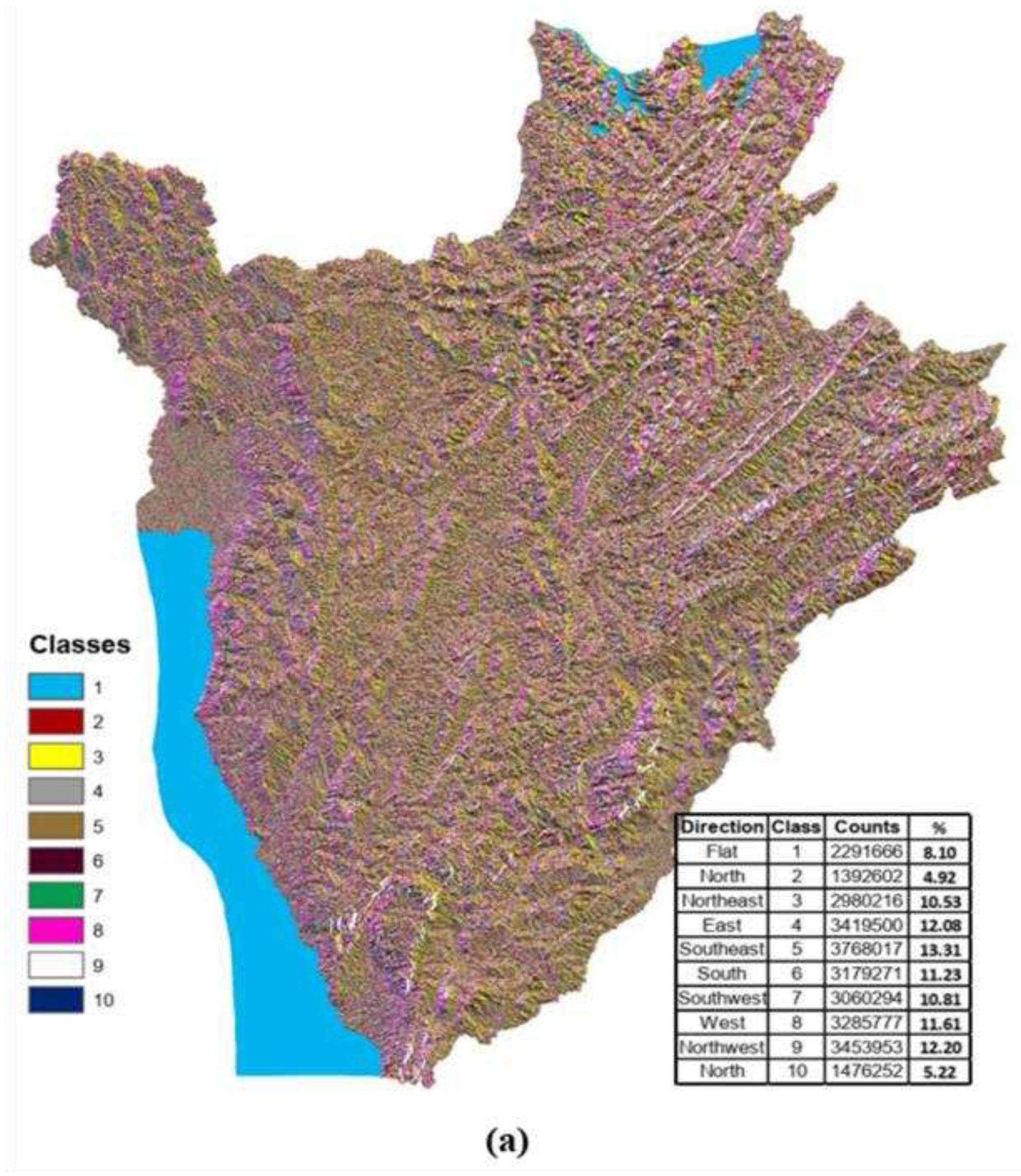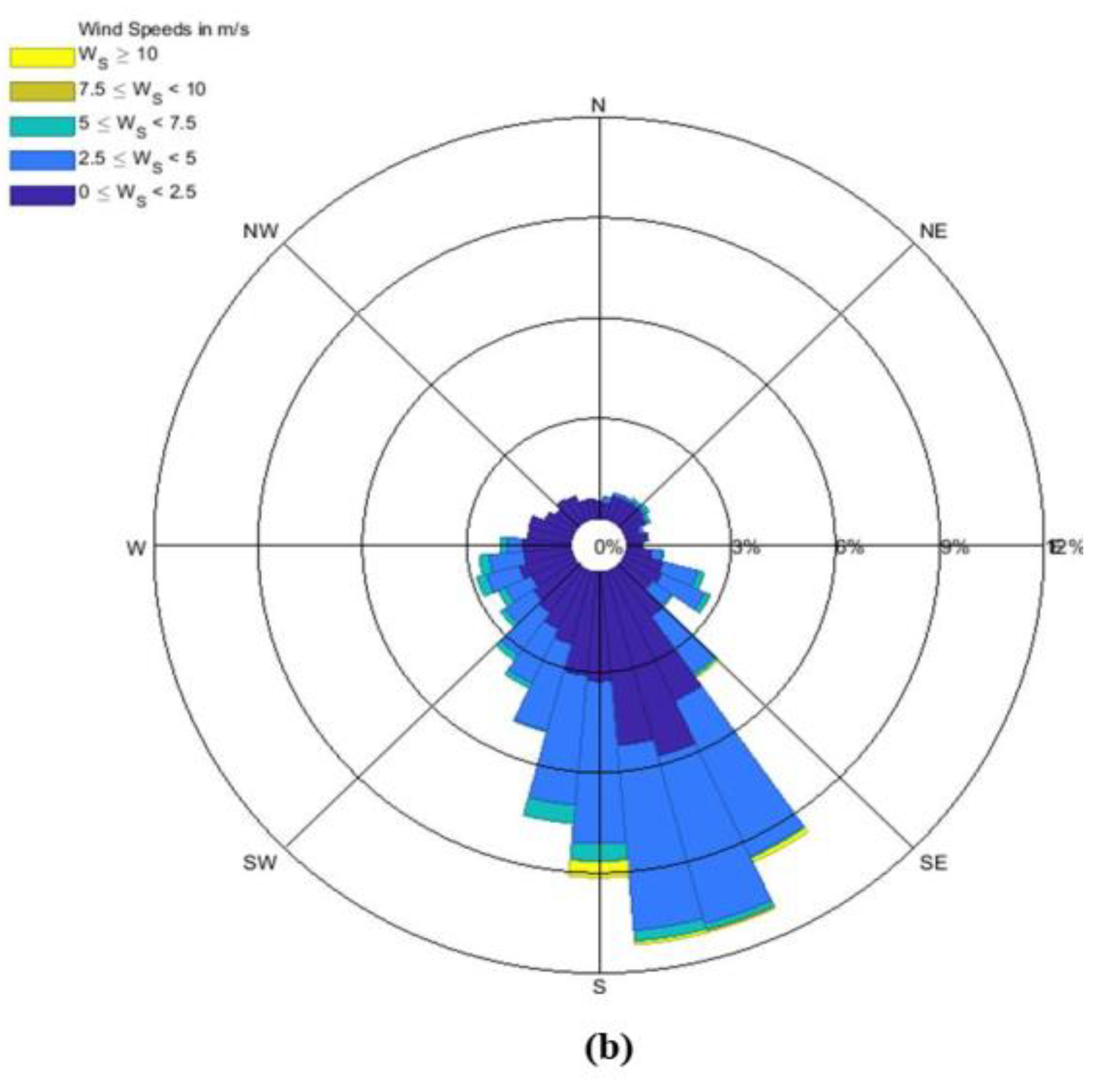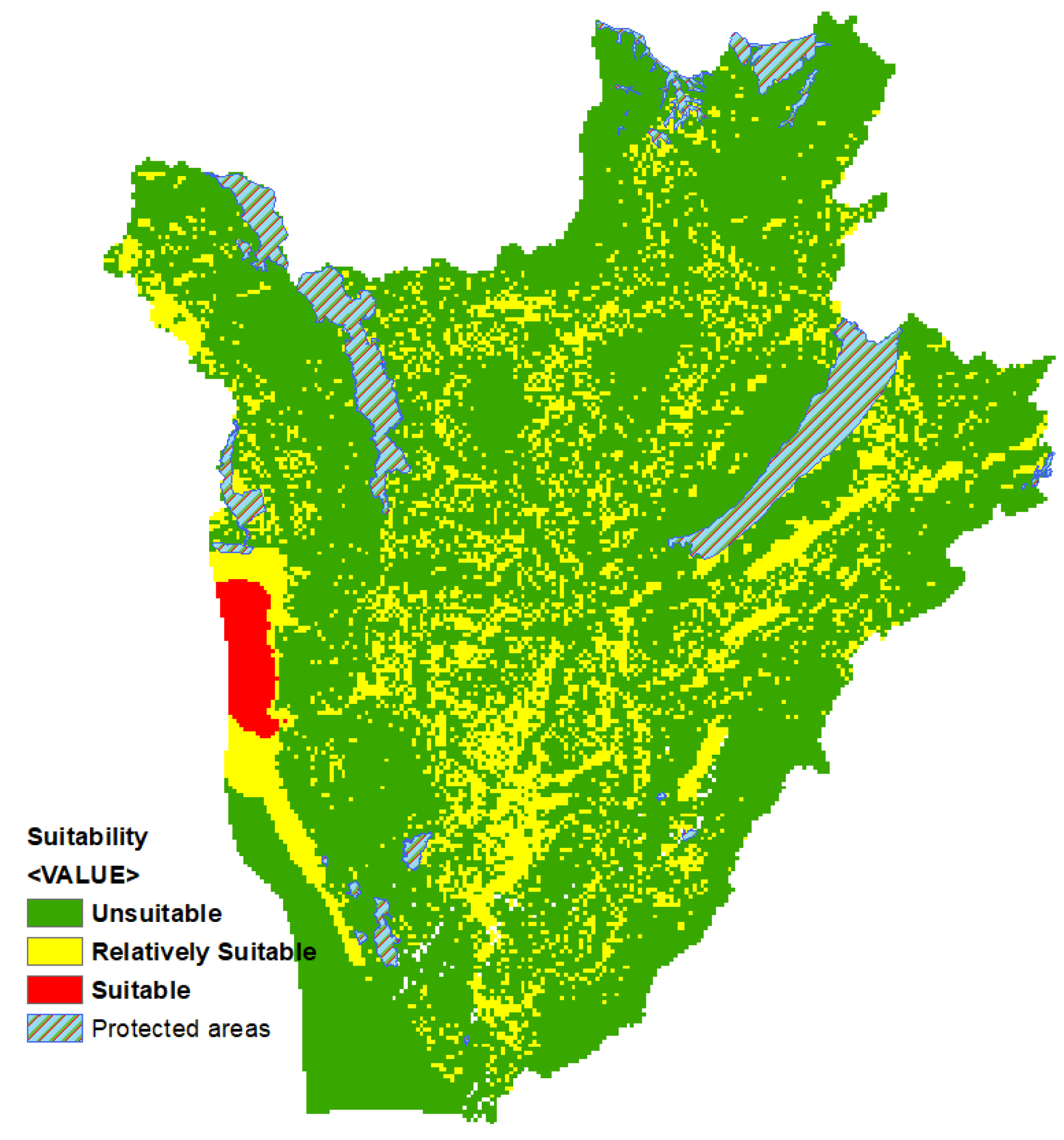1. Introduction
Energy is a major factor in any country's sustainable development and prosperity. However, the growing trend in energy demand is followed by an increase in global use of fossil fuels, and their excessive use results in significant climate, environmental and health costs [
1], [
2]. With this rapid energy demand increase, the development of technology for harvesting renewable energy has also accelerated. According to the Global Wind Energy Council (GWEC), wind power production has recently ascended as the world's fastest-growing source of energy. With a cumulative wind power generation capacity of 837 GW, 93.6 GW of wind turbine capacity was deployed at the end of 2021[
3].
The year 2021 registered new installations of ~93.6GW, bringing a global cumulative wind energy capacity to 837 GW, at a 12% annual growth rate. Wind energy is one of the most promising, mature, and rapidly developing renewable energy sources [
4], [
5]. Its fastest-growing is explained by the fact it is considered to be a clean, reliable and renewable energy resource that positively contributes to minimizing the issue of worldwide concerns about climate change and energy sources [
6]. Moreover, wind resources are intrinsically unpredictable due to their dependency on geographic and climatic factors, as well as the time of the region under consideration. This results in different values from one place and time to another in daily and seasonal changes. Based on that, there is a clear need for an effective assessment of the suitable placements for the installation of wind turbines to maximize wind energy production while minimizing the effect of different challenges. Before development, manufacture, installation, commissioning and operation there is a need to process site selection at an early stage to assess the feasibility of wind farms in light of environmental concerns, economic feasibility, and other criteria [
7], [
8].
At a given scale, Wind energy is generated by installing wind farms in windy areas. The selection of a turbine type that fulfils the topographical, climatic, as well as time variations and characteristics of the wind farm site is essential during the construction of a sustainable wind farm. The process of making a choice is often influenced by various factors, where multiple decision criteria conflict with each other. There exist several strategies that can be employed to effectively tackle the challenges of selecting turbines, considering their multi-criteria nature. They fall under the domain of multi-criteria decision-making (MCDM). MCDM is an operation sub-discipline that assesses several competing factors in decision-making.
MCDM methods are used to handle decision problems involving multiple factors in the decision-making process. These criteria conflict with each other and are mutually incommensurable. Incommensurability refers to a scenario where the decision criteria have different units and magnitudes. Numerous MCDMs have been developed by researchers and each has advantages as well as disadvantages; therefore, the choice of which one to use is also an important decision. Some common techniques are the weighted sum method, PROMETHEE, TOPSIS, VIKOR, ELECTRE, goal programming, AHP, Grey relation analysis, minimum manhattan distance (MMD) approach and Fuzzy logic, among others [
9]–[
12].
The MCDM methods have a major limitation, except for the fuzzy logic, in case they are designed to deal with problems where the decision is to be made based on the 'AND' operation between the criteria. When dealing with situations where the choice is determined by an 'OR' operation, these approaches are ineffective. The fuzzy logic technique, on the other hand, can handle decision rules that include 'AND' or 'OR' operations. Furthermore, this technique can handle circumstances involving mixed 'AND-OR' type rules, which is the basic explanation to employ fuzzy logic to develop and implement multiple decision criteria for wind farm site selection. An additional aspect that makes fuzzy logic an attractive option for the multi-criteria wind farm site selection problem is its computational efficiency [
13], [
14].
Presently, in Burundi country, few studies related to wind resource assessment have been undertaken. Furthermore, no research has focused on the selection of optimal wind farm placements and their classification. Further research is highly required to get general information on Burundi wind resource potential and its repartition throughout the territory. This will help decision-makers to know which type of wind farms fit well in Burundi and at which scale they can contribute to future projects.
This paper aims to evaluate the availability of sites to implant wind farms in different places in Burundi. We will utilize a GIS tool to create a decision matrix that includes options for evaluation. We will elucidate the proposed case by incorporating a mix of fuzzy logic approaches. The rest work of this paper is divided into the following sections: the second section describes the methodology used to solve the considered problem; the third section provides a comprehensive description, analysis, and discussion of both the GIS and the proposed decision problem.; the fourth section presents the results and engages in a thorough discussion of these findings. Lastly, the fifth section succinctly outlines the main conclusions derived from this study.
2. Methodology
The economic viability of a wind project greatly depends on identifying the most suitable areas for wind farm development. There is a need to find a systematic approach to determine where these potential locations exist as well as the cost of power production. With this objective, a fuzzy GIS-MCDM-based approach is recommended as the best tool for wind farm sitting based on prior research [
15]–[
17]. The AHP is a well-known technique of the MCDM methods in wind farm site selection. The AHP method is an extremely effective and well-structured technique for organizing and analyzing complex decisions, such as determining the optimal location for wind farms [
18]-[
20].
Table 1 displays some previous research undertaken on the subject of wind farm site selection problems conducted in some countries.
2.1. Geographic Information Systems
Geographic Information Systems (GIS) are powerful computer-based tools that gather, analyze, store, model, and display data that is specifically referenced to locations on Earth. The main function of GIS comprises geoprocessing, 3D visualization, interoperability, cartography and infrastructure. These applications assist planners and decision-makers as an effective tool for solving complex spatial problems. Nowadays, GIS is widely used in a variety of academic subjects including wind technologies. It is intended for the recovery, storage, manipulation, analysis, and mapping of geographical data [
16], [
31].
GIS uses two types of coverage representations: vector and raster. The raster is a rectangular grid of pixels that contains specific details about a given geographic location. Vectors, on the other hand, maintain a geometric form (points, lines, and polygons) that specifies limitations associated with a reference system [
32].
This information storage is presented in a geodatabase, which provides data order, structure, and standardization. In this study, Because of the continuous examination of spatial variables such as wind speed, terrain elevation, air density, and plant cover, among others, all geographic information in this study was treated as a raster [
33]. The raster procedure
The raster procedures analyze problems fast, including mathematical combinations such as the MCDM techniques. In a GIS environment, the MCDM is based on criteria stated by a georeferenced cartographic information layer [
34]. In this work, the ArcMap software was used to rasterize and standardize the layer under linear and logistic functions.
2.2. Fuzzy logic tools brief description
The fuzzy logic tool is based on Zadeh's fuzzy set theory, which he proposed in 1965 [
35]. The fuzzy set theory offers a framework in which several conceptual phenomena can be precisely and rigorously analyzed. Furthermore, it can also be considered as a modelling language, fitting for cases in which fuzzy relations, criteria, and phenomena exist. A fuzzy logic tool is an essential tool in risk assessment in the way it compensates for the lack of knowledge and ambiguity faced when assessing the risks related to complex technological systems. It is also more useful when working with fuzzy linguistic concepts like low, medium, high, etc. [
36], [
37].
The main steps in the fuzzy-logic technique procedure are depicted in
Figure 1[
38]–[
40]:
Rule base: it contains all the rules and conditions defined by experts to control the decision-making system;
Fuzzification process: in this step, the input variable values are provided by experts. It permits to convert crisp inputs into fuzzy sets that correspond to the intuitive perception of the system’s status;
Inference engine: this component helps to determine the degree of match between fuzzy inputs and the rules. It is a main step because all information is treated in the inference engine. Based on the percentage match, it determines what control to perform in response to the different combinations of the input variables;
Defuzzification: this process is performed to convert significant fuzzy outputs into specific output variables.
2.3. GIS-MCDM technique
GIS-MCDM combination allows evaluation of the criteria and their factors by the mean of characteristics within a specific range of decision rules and assessment. The technique is commonly used to select ideal site processes in a huge variety of scientific fields [
16]. Lots of the problems people have in suitable site selection are geographic and, thus, coupling GIS with the MCDM method has the potential to solve such complex decision-making problems [
4], [
17]. Concerning optimal wind farm site selection, the GIS-MCD methods have been standardized to effectively search for and select the best wind sites [
37].
2.3.1. GIS-MCDM approach
The main steps followed by the GIS-MCDM technique are [
41]:
Problem definition. Try to define and understand the problem by fixing the goal or objective as clearly as possible;
Criteria and limitations determination through a combination of experts’ opinions and information from various sources;
Transform values onto a relative scale to allow comparison between each of the criteria;
Weight assignment to criteria in regards to the fixed objective and respect for each other;
Combine, synthesize and aggregate criteria together;
Analyze and then approve results.
As shown in
Figure 2, the GIS-MCDM process for suitable wind farm site selection has several stages. After the criteria determination, their hierarchy must be defined to calculate corresponding weights. All criteria are converted into standard values and combined using the weighted linear combination method, a widely used method [
42] that is based on the factors’ weighted aggregation, to finally generate a suitability map.
2.4. Fuzzy AHP
The AHP methodology, first established by Saat in 1980 [
41], is widely acknowledged as a robust and flexible MCDM method for dealing with complex decision problems [
28]. The decision maker can utilize it to effectively analyze complex decision problems that involve various criteria and obtain accurate results. The AHP enables a more comprehensive examination of the intricate facets of objective aspects related to a problem. Furthermore, it helps ensure the accuracy and constancy of their evaluation, thereby minimizing potential human errors during the decision-making procedure.
The AHP process through three main stages to get the final decision [
43]:
- -
Develop complex problems in a hierarchy of goals, alternatives, and criteria to assess those alternatives;
- -
Comparison of alternatives at each level of the hierarchy, one criterion at a time;
- -
At last, generate a vertically-oriented decision-making matrix that spans across the multiple levels of the hierarchy.
Despite its strengths, AHP does have some weaknesses. For instance, there is a mutual dependency among alternatives, which can occasionally result in relatively less accurate outcomes. Additionally, when multiple decision-makers with different perspectives are involved, defining criterion weights can become more complex. Furthermore, AHP relies on opinions and experience-based data collection, which may introduce some limitations. The main problem encountered when utilizing the AHP lies in the presence of uncertain, biased, and vague opinions expressed by experts. [
10], [
43], [
44].
The classical AHP method was extended to the fuzzy sets theory and the fuzzy AHP (FAHP) has been developed to handle complex decision problems accurately and more systematically than the simple AHP scheme. This technique integrates the fuzzy set theory concept with basic AHP. It displays the elaboration of a standard AHP into a fuzzy domain by applying fuzzy numbers rather than real numbers [
41].
The FAHP application process is summarized below [
45], [
46]:
Step 1: This step consists of defining a fuzzy pairwise comparison matrix. This matrix consists of the main criteria that may have an impact on the problem under investigation. Diagonal matrices are built using the hierarchical structure's sub-criteria. Decision-makers utilize fuzzy linguistic terms to assign the significance of one criterion over another. To achieve this, the decision-makers refer to
Table 1. The resulting pairwise comparison matrix is given by equation (1):
Where is the pairwise comparison matrix and is the joined comparison value of the criteria and .
Step 2: This step consists of aggregating the pairwise comparison matrices. In this study calculations of the judgement matrix are done using fuzzy triangular numbers (
Table 3).
Land use and land cover (LULC) refers to the standard restriction areas such as archaeological sites, forests, wetlands, seaports, aviation zones, military zones, water bodies, and urban areas from which wind turbines should be placed at a specific distance.
The decision-makers are aggregated using equation (2):
where A ̃=(l_ij,m_ij,u_ij ) and K represents the number of decision-makers.
Step 3: This computes the fuzzy weights matrix. The fuzzy comparison values are first calculated in this stage.
Next, fuzzy weights
of the criteria are calculated as follows:
Where denotes the geometric mean of the fuzzy comparison values and are the criteria weights.
Step 4: The center-of-area approach is used to defuzzify fuzzy weights.
Step 5: Crisp weights normalization using equation (6):
2.5. Criteria determination
The optimal wind farm site selection problem depends on several criteria that include attributes and objectives. They can differ from the different areas and should have some properties to adequately represent the multi-criteria. Criteria must also be comprehensive and measurable [
48], [
49]. Consequently, to assess well the criteria, it is important to identify such relevant factors affecting the optimal wind farm site selection typically including topographic, geographic, climatic, socio-environmental, economic, location and political aspects.
For this study, the choice of evaluation criteria is based on previous various studies and is categorized into two main categories, restriction and exclusion criteria (See
Table 3). The exclusion criteria comprise legally protected areas such as natural reserves, seaports, airports, and tourist sites. The areas dropping under this category are rejected and consequently not eligible for wind farm sites. Conversely, restriction criteria define a distance to be respected from the selected zone for the implementation of wind farms. The distance can be determined in terms of a buffer zone inside which the wind farm cannot be constructed. Some examples of those zones are found around settlements, water bodies, natural parks, airports, and aircraft landing corridors, among others (see
Figure 4 for this study).
The construction of wind energy facilities must consider that the selected location is not subject to any legal restrictions but also has a set of factors influencing the decision. The choice of those factors is primarily dictated by the study area. Therefore, based on studies so far done, this study classified these factors into three general groups (geographical factors, climatological factors, and geographical location factors) [
29], [
32], [
50], [
51]. The factors are divided into a set of criteria that impact the selection of the wind turbine location and will make one site preferable rather than another. These are summarized in
Figure 5 and each of these is briefly described [
52], [
53]:
2.5.1. Wind speed
The local wind speed (intensity, direction, consistency, and uniformity) is the most important factor which plays a key role in wind farm project performance. A wind turbine's energy generation is directly proportional to the cube of the wind speed, and it is given by:
where
is the power produced by the wind turbine in watts (W),
is the area swept by the turbine blades in square meters,
is the air density in
, and
is the wind speed in m/s. Wind speed is the key factor of wind power development. Doubling the wind velocity gives eight times the wind power. Therefore, wind velocity is very important for optimal wind farm site locations.
2.5.2. Slope
Land slope influences the cost involved in wind farm implementation due to the difficulties in access and groundwork on sloppy lands. In many studies, reference is taken in the range of
[
24]–[
26], [
29]. Hence, high priority is given to flat grounds and locations with lower slopes when selecting regions for wind farm installation. Therefore, it is convenient the slope should not be too large to facilitate the accessibility of maintenance and installation equipment.
2.5.3. Elevation
Wind resource varies with altitude and is better at high altitudes but decreases at very high altitudes due to air density decrease. Elevation above 2000m, is sometimes considered the cut-off altitude [
54]. Hence, ground elevation is also considered a factor in the choice of the best wind farm location. Therefore, flat terrain will be favourable for wind farm project construction, operation, and maintenance [
55].
2.5.4. Aspect
The better the aspect of the wind farm's location, the more straightforward it is to erect. As a result, the slope at the location of the wind farm should be oriented toward the prevailing wind blow [
16], [
56]. In terms of wind potential, the slope orientation concerning wind direction is one of the crucial factors [
57].
2.5.5. Distance to airports/sea ports
It is recommended to install wind farms at a distance from airports/seaports and similar facilities. It is highly recommended to install wind farms in locations that are at a considerable distance from airports and seaports [
50].
2.5.5. Proximity to main roads
Being close to the main road network is crucial in reducing transportation costs and facilitating material transport for wind turbine implementation [
55]. The distance from the main roads is a significant economic factor, and therefore, the best location for a wind farm should be one that is near existing roads, rather than building new ones to access the site [
57].
2.5.6. Proximity to national grids
Since wind energy must be connected to the grid, the proximity to the national grid affects the cost of a wind farm. Increasing the distance between the wind farm and the electrical grid will inevitably lead to higher transmission costs [
17], [
32]. Hence, the power transport to consumers using the existing power transmission lines hugely reduces the project cost.
Figure 6 illustrates a variety of maps that depict the restriction factors that impact the process of selecting suitable sites for wind farms. The Burundi maps of high voltage electric lines and national roads were obtained from the official reports published in Burundi country and are digitalized using ArcGIS software [
58], [
59]. The wind speed map is the outcome of the ArcGIS process obtained using weather research and forecasting model (WRF) output simulations. The slope, aspect and elevation map factors for this work were obtained using ArcGIS software and digital elevation model (DEM) data. The DEM is downloaded from the ‘U.S. Geological Survey (USGS) EarthExplorer tool’ [
60].
2.6. Weighted Linear Combination
In the field of GIS-based decision-making analysis, the weighted linear combination (WLC) is a frequently utilized technique for combining decision criteria in the MCDM procedure. The WLC operates based on the idea of using a weighted average. This means that continuous criteria are brought together on a common numeric scale and then combined with the right weights [
61]. The decision maker is responsible for assigning weights to each attribute map layer based on their relative importance. The score for an alternative is calculated by multiplying the importance weight of each attribute by its corresponding scaled value and then adding the products of all attributes. This process is carried out for all options, and the one with the highest score is selected. This method can be easily implemented using any GIS system that has overlay capabilities. It enables the combination of evaluation criterion map layers to determine the ultimate composite map layer that will be generated as the output. These methods can be implemented using both raster and vector GIS environments [
25], [
61].
The WLC method combines factors by assigning a weight to each of them and then adds up the results to create a comprehensive suitability map [
61]:
Where is the suitability, is the number of criteria, is the value of criterion , and is the weight of factor .
When Boolean restrictions are employed (for example, restricted areas), the procedure is adjusted by multiplying the suitability obtained from the factors by the product of the constraints [
24]:
where
corresponds to the criterion score of constraint
.
Figure 7 provides a concise summary of the proposed research methodology, incorporating all the previously mentioned details.
2.7. Study area
Burundi, a landlocked country, is located in eastern Africa, sharing its borders with the Democratic Republic of Congo to the west, the Republic of Tanzania to the south and east, and Rwanda to the north. Burundi is located at 29° 20' 52.4976'' E longitude and 3° 21' 40.5360'' S latitude. It has a 27,834 km²area with a population of 11.89 million in 2020 [
62].
Burundi's topographical structures are a captivating mix of complexity, stretching from the west to the east of the country. The lowlands form a vast expanse of plains that extend from the southern region to the northwest of the country. These plains exhibit different widths and have elevations ranging from 758 meters to 1000 meters above mean sea level (a.m.s.l). The Mirwa escarpment, nestled between the lowlands and the Congo-Nile ridge, is a breathtaking landscape marked by steep slopes and slender ridges. The average altitude of the area ranges from 1000 meters to 1500 meters a.m.s.l. The Congo-Nile Ridge stands as an asymmetrical and irregular feature within the topography of Burundi. It demarcates the boundaries separating the Congo and Nile River basins. The central plateau stands tall with its elevation ranging from 1500 m to over 2000 m above mean sea level, stretching gracefully towards the west and south. The eastern depression encompasses the valleys of the rivers that lie between Burundi and Tanzania, namely the Malagarazi and Rumpungwe. On the other hand, the northern depression is characterized by the Bugesera region, which extends into Rwanda. Lastly, the Congo-Nile massif is a dissymmetric mountain block of the western rift flank with elevations varying between 2000 m and 2675 m [
63], [
64].
3. Results and discussion
This section can be subdivided using subheadings. The description of the experimental results, their interpretation, and the derived experimental conclusions should be both concise and precise.
In this section, we will present and analyze the results of the FAHP-GIS in the context of spatial analysis of wind turbine locations in Burundi. This includes the numerical values representing the optimal weight of the evaluation factors and the suitability map for the optimal wind sites.
3.1. FAHP results
In this study, the optimal weights of the six restriction factors mentioned in section 2.5 are obtained using the FAHP-based MCDM method.
Table 3 provides the numerical weights for each criterion, obtained through the use of Fuzzy pairwise comparison matrices. The obtained weights corresponding to the six criteria are given in
Table 4.
According to the findings, the wind potential carries the greatest weight among other factors, amounting to an impressive 42.3% percentage. This means the wind potential has a high priority in the selection of the optimal areas for the implementation of wind farms. It is followed by the slope, proximity to the grids, distance from the roads, aspect and LULC with 25.3%, 13.3%, 7.8%, 7.3% and 4% respectively.
3.2. land suitability mapping for wind farm site placement
3.2.1. Wind potential reclassification
As mentioned on the map, the wind speed is classified into four scales: very good, good, moderate, and poor. About 2.10% of the land area registered very high, 30.67% high, 47.52% moderate and 19.72% low wind speed. The cut-in wind speed typically ranges between 2.5 and 4m/s [
65]. About 32.77% of the total land area is highly compatible with wind turbines, classified as class 3 and 4 if we solely consider the wind speed factor.
3.2.2. Elevation model reclassification
According to the map of the DEM of Burundi (
Figure 9),13%,30% and 50% are situated in the elevation ranging from 739 to 1000m,1000-1500m and 1500-2000m a.g.l respectively. These regions correspondingly represent extremely, very strongly, strongly preferred places for the implementation of wind farms. As it has been mentioned in section 2.5.3, the altitude of 2000m is considered the cut-off favourite elevation for wind resources. Accordingly, for Burundi, about 7% of the land area has an elevation above 2000m making it an unsuitable or less preferred place for wind farm placement. More than 90% of Burundi's land is suitable for wind farms due to its elevation being less than 2000m.
3.2.3. Distance from major electrical transmission lines
Figure 11 displays the distance in km from the main national electric network. The area within a distance less than 5km from the electrical lines is strongly suitable and the land areas between 5km to 15 km are relatively suitable for wind site selection. However, it is considered impractical to implement wind farms in areas that are more than 15 km away from the national electric grid.
3.2.4. Distance from main roads
The maps of connectivity to main roads,
Figure 12, show different categories of the distance from the national roads. The land area situated at a distance of less than 0.5km and a distance greater than 20km is considered an exclusion zone for wind farm installation and represents 36% of Burundi. The Burundi land areas located at a distance in the range of 0.5 to 10km away from the main roads are considered a strongly suitable location for wind farms. Furthermore, the land areas located at a distance ranging from 10 to 20km are considered suitable for wind farm projects. In contrast, the land areas sited at a distance of 20km or farther away from the main road network are unsuitable or less preferred for the implementation of wind farms.
3.2.5. Slope model reclassification
Figure 13 displays the slope value distribution through Burundi. More than 70%of the Burundi, area is dominated by slope values below 15° with about 57% from 0-10° and 18% from10-15°. These areas are considered to be the most excellent places for wind farm installation considering the construction cost. Places with slopes varying between 15 and 25° represent 19% and they are considered relatively favourable for wind turbine siting. The remaining areas which have slopes >25° are not appreciated for the wind farm locations.
3.2.6. Aspect model reclassification
The two main attributes of wind are its speed and direction. These attributes impact the wind farm implementation to optimize its energy production. The prevalent wind blows direction and aspect orientation are two linked factors influencing wind turbine production. As it has been mentioned before, flat terrains are highly recommended when choosing the locations of wind turbines. Therefore, in this work, the aspect of Burundi is evaluated and the percentage aspect distribution is given for each direction. The map of the aspect model of Burundi,
Figure 14 (a), revealed that the aspect orientation consists of flat terrain by 8.1%, the north by 10.13%, the northeast by 10.53%, the east by 12.08%, the southeast by 13.31%, the south by 11.23%, the southwest by 10.81%, the west by 11.61% and the northwest by 12.2%. The wind rose of Burundi,
Figure 14 (b) is produced using on-field data obtained from the meteorological institution Institut Géographique du Burundi (IGEBU) through Matlab software. As shown in previous studies, Burundi's predominant wind blow is from southwest to southeast [
66]. Consequently, the southeast, south and southwest aspect orientations are the fitting direction for wind farm implementation in Burundi. To this is added the flat land to totalize 43.45% of potential locations for wind farm construction in Burundi in terms of direction consideration.
3.3. Identification of the optimal locations for the wind farm
The weighted values are utilized to determine the degree of suitability for the wind turbine site selection of Burundi. Based on the annual average wind values and other factors,
Figure 6, the wind farm site suitability map,
Figure 15, displays three classes of sites. Locations with an average wind speed of less than 2.5 m/s are deemed inappropriate for the installation of wind farms. On the map, the land area in green colour is unsuitable to be a candidate for a wind farm at any scale. The area in yellow colour represents the relatively suitable locations for wind farm sitting. The region in red colour is highly recommended as a suitable area to be a candidate for wind turbine sitting.
The main part of the suitable region is located in Lake Tanganyika, in the western part of Burundi. In addition to unsuitable areas, we have exclusion zones, which cannot be possible candidates for wind farm installation. Such zones are found as protected areas on the Burundi wind farm site suitability map (
Figure 15). They include forests, an airport, port natural reserves and north lakes.
In terms of percentage, the developed wind suitability map revealed that 20.91% of the studied regions are suitable for wind power facilities installation; but only 1.96% of Burundi territory is highly suitable. The remaining 79.09% of the territory is unsuitable for wind turbine installation.
4. Conclusion
This study used the MCDM system coupled with GIS to produce the wind suitability map of Burundi. The WRF model simulation outputs over Burundi territory were employed to classify the regions in terms of wind speed potential. Topographical, climatological, and location restriction factors were established. These restrictions such as aspect, slope, elevation, distance from major electrical transmission lines, distance from main roads and the protected zones divided the Burundi country into suitable and unsuitable areas for wind power facilities placement.
The results indicate that the Burundi territory has highly favourable areas for extracting wind energy, making it suitable for implementing medium-scale wind farms. The western part of the country has the highest potential for wind farms. The results signify about 1.96% of the hall country with the highest wind farm potential. At the same time, approximately 19% of the study area registers relatively suitable wind farm potential.
As it is the first time this kind of study has been used to evaluate the optimal wind site selection over Burundi, it is recommended that further research focus on additional methods for optimal wind site selection to compare the results.
Funding
“This study received no external funding”
Data availability statement
The corresponding author can provide the land suitability data used in this study upon request.
Acknowledgements
The authors want to express gratitude to the African Centre of Excellence in Energy for Sustainable Development ACEESD), University of Rwanda for providing a suitable academic environment.
Conflicts of interest
The authors have stated that they do not have any conflicts of interest.
References
- IEA, “World Energy Outlook 2021 : Part of the World Energy Outlook,” Int. Energy Agency, p. 386, 2021, [Online]. Available: https://www.iea.org/reports/world-energy-outlook-2021.
- S. Mohammadzadeh Bina, S. Jalilinasrabady, H. Fujii, and H. Farabi-Asl, “A comprehensive approach for wind power plant potential assessment, application to northwestern Iran,” Energy, vol. 164, pp. 344–358, 2018. [CrossRef]
- J. Lee and F. Zhao, “GWEC. GLOBAL WIND REPORT 2022. https://neec.no/global-wind-report-2022/,” 2022.
- S. K. Saraswat, A. K. Digalwar, S. S. Yadav, and G. Kumar, “MCDM and GIS-based modelling technique for assessment of solar and wind farm locations in India,” Renew. Energy, vol. 169, pp. 865–884, 2021. [CrossRef]
- S. Ali, J. Taweekun, K. Techato, J. Waewsak, and S. Gyawali, “GIS based site suitability assessment for wind and solar farms in Songkhla, Thailand,” Renew. Energy, vol. 132, pp. 1360–1372, 2019. [CrossRef]
- J. E. Diffendorfer et al., “Demographic and potential biological removal models identify raptor species sensitive to current and future wind energy,” Ecosphere, vol. 12, no. 6, 2021. [CrossRef]
- B. Wu, T. L. Yip, L. Xie, and Y. Wang, “A fuzzy-MADM based approach for site selection of offshore wind farm in busy waterways in China,” Ocean Eng., vol. 168, no. August, pp. 121–132, 2018. [CrossRef]
- G. Damousis, M. C. Alexiadis, J. B. Theocharis, and P. S. Dokopoulos, “A fuzzy model for wind speed prediction and power generation in wind parks using spatial correlation,” IEEE Trans. Energy Convers., vol. 19, no. 2, pp. 352–361, 2004. [CrossRef]
- A. Mardani, A. Jusoh, K. M. D. Nor, Z. Khalifah, N. Zakwan, and A. Valipour, “Multiple criteria decision-making techniques and their applications - A review of the literature from 2000 to 2014,” Econ. Res. Istraz. , vol. 28, no. 1, pp. 516–571, 2015. [CrossRef]
- M. Gr, Fuzzy Sets, Fuzzy Logic and Their Applications. 2020. [CrossRef]
- V. Indrajayanthan and N. K. Mohanty, “Assessment of Clean Energy Transition Potential in Major Power-Producing States of India Using Multi-Criteria Decision Analysis,” Sustain., vol. 14, no. 3, 2022. [CrossRef]
- G. Łaska, “Wind Energy and Multicriteria Analysis in Making Decisions on the Location of Wind Farms: A Case Study in the North-Eastern of Poland,” Model. Simul. Optim. Wind Farms Hybrid Syst., no. Mcdm, pp. 1–18, 2020. [CrossRef]
- S. Perkin, D. Garrett, and P. Jensson, “Optimal wind turbine selection methodology: A case-study for Búrfell, Iceland,” Renew. Energy, vol. 75, pp. 165–172, 2015. [CrossRef]
- Sedaghat, F. Alkhatib, A. Eilaghi, M. Sabati, L. Borvayeh, and A. Mostafaeipour, “A new strategy for wind turbine selection using optimization based on rated wind speed,” Energy Procedia, vol. 160, no. 2018, pp. 582–589, 2019. [CrossRef]
- S. Cavazzi and A. G. Dutton, “An Offshore Wind Energy Geographic Information System (OWE-GIS) for assessment of the UK’s offshore wind energy potential,” Renew. Energy, vol. 87, no. 2016, pp. 212–228, 2016. [CrossRef]
- G. Villacreses, G. Gaona, J. Martínez-Gómez, and D. J. Jijón, “Wind farms suitability location using geographical information system (GIS), based on multi-criteria decision making (MCDM) methods: The case of continental Ecuador,” Renew. Energy, vol. 109, pp. 275–286, 2017. [CrossRef]
- M. Li, Y. Xu, J. Guo, Y. Li, and W. Li, “Application of a GIS-Based Fuzzy Multi-Criteria Evaluation Approach for Wind Farm Site Selection in China,” pp. 1–19, 2020.
- T. R. Ayodele, A. S. O. Ogunjuyigbe, O. Odigie, and J. L. Munda, “A multi-criteria GIS based model for wind farm site selection using interval type-2 fuzzy analytic hierarchy process: The case study of Nigeria,” Appl. Energy, vol. 228, no. July, pp. 1853–1869, 2018. [CrossRef]
- R. Aliyev, H. Temizkan, and R. Aliyev, “Fuzzy analytic hierarchy process-based multi-criteria decision making for universities ranking,” Symmetry (Basel)., vol. 12, no. 8, pp. 1–15, 2020. [CrossRef]
- İ. Kaya, M. Çolak, and F. Terzi, “A comprehensive review of fuzzy multi criteria decision making methodologies for energy policy making,” Energy Strategy. Rev., vol. 24, no. March, pp. 207–228, 2019. [CrossRef]
- Alhuyi Nazari, M.; Assad, M.E.H.; Haghighat, S.; Maleki, “Applying TOPSIS Method for Wind Farm Site Selection in Iran,” Adv. Sci. Eng. Technol. Int. Conf. (ASET), Dubai, United Arab Emirates, 4 February–9 April 2020;, no. 4 February–9 April 2020, p. 4, 2020.
- F. Ecer, “Sustainability assessment of existing onshore wind plants in the context of triple bottom line: a best-worst method (BWM) based MCDM framework,” Environ. Sci. Pollut. Res., vol. 28, no. 16, pp. 19677–19693, 2021. [CrossRef]
- J. Gao, F. Guo, Z. Ma, X. Huang, and X. Li, “Multi-criteria group decision-making framework for offshore wind farm site selection based on the intuitionistic linguistic aggregation operators,” Energy, vol. 204, p. 117899, 2020. [CrossRef]
- S. Zalhaf et al., “A high-resolution wind farms suitability mapping using gis and fuzzy ahp approach: A national-level case study in Sudan,” Sustain., vol. 14, no. 1, 2022. [CrossRef]
- T. S. M. Cunden, J. Doorga, M. R. Lollchund, and S. D. D. V. Rughooputh, “Multi-level constraints wind farms sitting for a complex terrain in a tropical region using MCDM approach coupled with GIS,” Energy, vol. 211, p. 118533, 2020. [CrossRef]
- H. Yousefi, S. G. Motlagh, and M. Montazeri, “Multi-Criteria Decision-Making System for Wind Farm Site-Selection Using Geographic Information System (GIS): Case Study of Semnan Province, Iran,” Sustainability, vol. 14, no. 13, p. 7640, 2022. [CrossRef]
- T. R. Ayodele, A. S. O. Ogunjuyigbe, O. Odigie, and J. L. Munda, “A multi-criteria GIS based model for wind farm site selection using interval type-2 fuzzy analytic hierarchy process: The case study of Nigeria,” Appl. Energy, vol. 228, no. June, pp. 1853–1869, 2018. [CrossRef]
- J. M. Sánchez-Lozano, M. S. García-Cascales, and M. T. Lamata, “GIS-based onshore wind farm site selection using Fuzzy Multi-Criteria Decision Making methods. Evaluating the case of Southeastern Spain,” Appl. Energy, vol. 171, no. 2016, pp. 86–102, 2016. [CrossRef]
- Y. Xu et al., “Site selection of wind farms using GIS and multi-criteria decision making method in Wafangdian, China,” Energy, vol. 207, 2020. [CrossRef]
- A. Ajanaku, M. P. Strager, and A. R. Collins, “GIS-based multi-criteria decision analysis of utility-scale wind farm site suitability in West Virginia,” GeoJournal, vol. 0123456789, 2021. [CrossRef]
- R. Mu and P. Airlangga, “Design Mapping Categories on Geographic Information Systems,” vol. 1, no. 2, pp. 2–6, 2021.
- E. Aksoy and B. T. San, “Geographical information systems (GIS) and Multi-Criteria Decision Analysis (MCDA) integration for sustainable landfill site selection considering dynamic data source,” Bull. Eng. Geol. Environ., vol. 78, no. 2, pp. 779–791, 2019. [CrossRef]
- J. Zhou, Y. Wu, C. Wu, F. He, B. Zhang, and F. Liu, “A geographical information system based multi-criteria decision-making approach for location analysis and evaluation of urban photovoltaic charging station: A case study in Beijing,” Energy Convers. Manag., vol. 205, no. November 2019, p. 112340, 2020. [CrossRef]
- M. S. Hussaini, A. Farahmand, S. Shrestha, S. Neupane, and M. Abrunhosa, “Site selection for managed aquifer recharge in the city of Kabul, Afghanistan, using a multi-criteria decision analysis and geographic information system,” Hydrogeol. J., vol. 30, no. 1, pp. 59–78, 2022. [CrossRef]
- H. J. Zimmermann, “Fuzzy set theory,” Wiley Interdiscip. Rev. Comput. Stat., vol. 2, no. 3, pp. 317–332, 2010. [CrossRef]
- R. Zwick and H.-J. Zimmermann, Fuzzy Set Theory and Its Applications, vol. 106, no. 2. 1993. [CrossRef]
- V. T. Nguyen, N. H. Hai, N. Thi, and K. Lan, “Spherical Fuzzy Multicriteria Decision-Making Model for Wind,” pp. 1–12, 2022.
- G. Abdelmassih, M. Al-Numay, and A. El Aroudi, “Map optimization fuzzy logic framework in wind turbine site selection with application to the usa wind farms,” Energies, vol. 14, no. 19, pp. 1–15, 2021. [CrossRef]
- M. Mustafa and A. Barabadi, “Criteria-Based Fuzzy Logic Risk Analysis of Wind Farms Operation in Cold Climate Regions,” Energies, vol. 15, no. 4, 2022. [CrossRef]
- O. Badran, E. Abdulhadi, and Y. El-Tous, “Fuzzy logic controller for predicting wind turbine power generation,” Int. J. Mech. Mater. Eng., vol. 6, no. 1, pp. 51–66, 2011.
- S. Ali, S. M. Lee, and C. M. Jang, “Determination of the most optimal on-shore wind farm site location using a GIS-MCDM methodology: Evaluating the case of South Korea,” Energies, vol. 10, no. 12, 2017. [CrossRef]
- L. Balogun, A. N. Matori, A. I. Hamid-Mosaku, D. Umar Lawal, and I. Ahmed Chandio, “Fuzzy MCDM-based GIS model for subsea oil pipeline route optimization: An integrated approach,” Mar. Georesources Geotechnol., vol. 35, no. 7, pp. 961–969, 2017. [CrossRef]
- S. Zalhaf et al., “A high-resolution wind farms suitability mapping using gis and fuzzy ahp approach: A national-level case study in Sudan,” Sustain., vol. 14, no. 1, pp. 1–21, 2022. [CrossRef]
- J. M. Sánchez-Lozano, A. R. Escudero, I. C. Gil-García, M. S. García-Cascales, and A. Molina-García, “Comparative Analysis Analysis Based based on GIS and Fuzzy MCDM Approaches . Case Study : Offshore Offshore Wind Wind Site Site Selection Selection in in the Gulf Gulf of of Maine,” vol. 3, no. Mcdm, pp. 211–218, 2021.
- A. Havle and B. Kılıç, “A hybrid approach based on the fuzzy AHP and HFACS framework for identifying and analyzing gross navigation errors during transatlantic flights,” J. Air Transp. Manag., vol. 76, no. September 2018, pp. 21–30, 2019. [CrossRef]
- ónal Özdemir, İ. Altinpinar, and F. B. Demirel, “A MCDM Approach with Fuzzy AHP Method for Occupational Accidents on Board,” TransNav, Int. J. Mar. Navig. Saf. Sea Transp., vol. 12, no. 1, pp. 93–98, 2018. [CrossRef]
- K. Tripathi, S. Agrawal, and R. D. Gupta, “Comparison of GIS-based AHP and fuzzy AHP methods for hospital site selection: a case study for Prayagraj City, India,” GeoJournal, vol. 0123456789, 2021. [CrossRef]
- M. Yalcin and F. Kilic Gul, “A GIS-based multi criteria decision analysis approach for exploring geothermal resources: Akarcay basin (Afyonkarahisar),” Geothermics, vol. 67, pp. 18–28, 2017. [CrossRef]
- Z. Dhunny, J. R. S. Doorga, Z. Allam, M. R. Lollchund, and R. Boojhawon, “Identification of optimal wind, solar and hybrid wind-solar farming sites using fuzzy logic modelling,” Energy, vol. 188, p. 116056, 2019. [CrossRef]
- J. M. Sánchez-Lozano, M. S. García-Cascales, and M. T. Lamata, “Identification and selection of potential sites for onshore wind farms development in the region of Murcia, Spain,” Energy, vol. 73, no. 2014, pp. 311–324, 2014. [CrossRef]
- M. Taoufik and A. Fekri, “GIS-based multi-criteria analysis of offshore wind farm development in Morocco,” Energy Convers. Manag. X, vol. 11, p. 100103, 2021. [CrossRef]
- E. Caceoğlu, H. K. Yildiz, E. Oğuz, N. Huvaj, and J. M. Guerrero, “Offshore wind power plant site selection using Analytical Hierarchy Process for Northwest Turkey,” Ocean Eng., vol. 252, no. October 2021, 2022. [CrossRef]
- M. Shafiee, “Wind Energy Development Site Selection Using an Integrated Fuzzy ANP-TOPSIS Decision Model,” Energies, vol. 15, no. 12, p. 4289, 2022. [CrossRef]
- Y. Noorollahi, H. Yousefi, and M. Mohammadi, “Multi-criteria decision support system for wind farm site selection using GIS,” Sustain. Energy Technol. Assessments, vol. 13, pp. 38–50, 2016. [CrossRef]
- T. N. Hoang, T. T. B. Ly, and H. T. T. Do, “A hybrid approach of wind farm site selection using Group Best-Worst Method and GIS-Based Fuzzy Logic Relations. A case study in Vietnam,” Environ. Qual. Manag., no. December 2021, pp. 1–17, 2022. [CrossRef]
- J. Feng, “Wind farm site selection from the perspective of sustainability: A novel satisfaction degree-based fuzzy axiomatic design approach,” Int. J. Energy Res., vol. 45, no. 1, pp. 1097–1127, 2021. [CrossRef]
- D. Pamucar, L. Gigovic, Z. Bajic, and M. Janoševic, “Location selection for wind farms using GIS multi-criteria hybrid model: An approach based on fuzzy and rough numbers,” Sustain., vol. 9, no. 8, 2017. [CrossRef]
- MinistèreDeL’EnergieEtDesMinesBurundi, “Etude diagnostique du secteur de l ’ Energie au Burundi dans le cadre de l ’ Initiative du Secrétaire Général des Nations Unies sur l ’ Energie durable pour tous ( Sustainable Energy for All ) Juin 2013 Réalisé avec l,” 2013.
- African Development Bank, “An Infrastructure Action Plan for Burundi: Accelerating Regional Integration,” no. September, 2009.
- US Geological Survey, “USGS EarthExplorer tool,” Usgs.gov, 2019. https://earthexplorer.usgs.gov/.
- S. Drobne and A. Lisec, “Multi-attribute decision analysis in GIS: Weighted linear combination and ordered weighted averaging,” Inform., vol. 33, no. 4, pp. 459–474, 2009.
- Tabutin and B. Schumacher, “The demography of subsaharan Africa in the 21st century,” Population (Paris)., vol. 75, no. 2–3, pp. 169–295, 2020.
- Nkunzimana, S. Bi, T. Jiang, W. Wu, and M. I. Abro, “Spatiotemporal variation of rainfall and occurrence of extreme events over Burundi during 1960 to 2010,” Arab. J. Geosci., vol. 12, no. 5, pp. 0–22, 2019. [CrossRef]
- M. Heckmann, S. Vassolo, and C. Tiberghien, “Groundwater Vulnerability Map (COP) for the Nyanzari catchment, Gitega, Burundi,” 2016. [CrossRef]
- Loukatou, S. Howell, P. Johnson, and P. Duck, “Stochastic wind speed modelling for estimation of expected wind power output,” Appl. Energy, vol. 228, no. May, pp. 1328–1340, 2018. [CrossRef]
- G. Placide, M. R. Lollchund, and G. A. Dalso, “Wind energy potential assessment of some sites in Burundi using statistical modelling,” 2021 IEEE PES/IAS PowerAfrica, PowerAfrica 2021, no. 1, pp. 1–5, 2021. [CrossRef]
|
Disclaimer/Publisher’s Note: The statements, opinions and data contained in all publications are solely those of the individual author(s) and contributor(s) and not of MDPI and/or the editor(s). MDPI and/or the editor(s) disclaim responsibility for any injury to people or property resulting from any ideas, methods, instructions or products referred to in the content. |
© 2023 by the authors. Licensee MDPI, Basel, Switzerland. This article is an open access article distributed under the terms and conditions of the Creative Commons Attribution (CC BY) license (http://creativecommons.org/licenses/by/4.0/).

